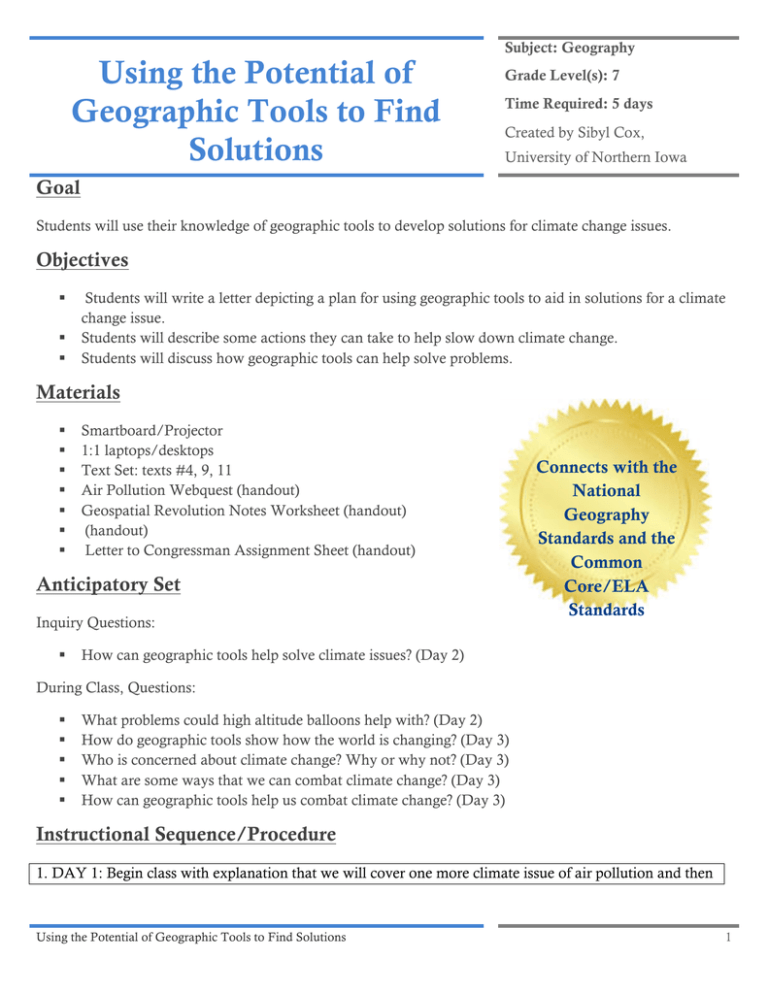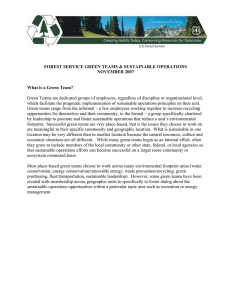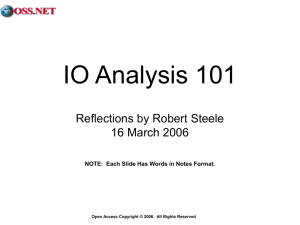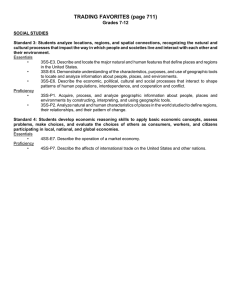Using the Potential of Geographic Tools to Find Solutions
advertisement

Subject: Geography Using the Potential of Geographic Tools to Find Solutions Grade Level(s): 7 Time Required: 5 days Created by Sibyl Cox, University of Northern Iowa Goal Students will use their knowledge of geographic tools to develop solutions for climate change issues. Objectives § § § Students will write a letter depicting a plan for using geographic tools to aid in solutions for a climate change issue. Students will describe some actions they can take to help slow down climate change. Students will discuss how geographic tools can help solve problems. Materials § § § § § § § Smartboard/Projector 1:1 laptops/desktops Text Set: texts #4, 9, 11 Air Pollution Webquest (handout) Geospatial Revolution Notes Worksheet (handout) (handout) Letter to Congressman Assignment Sheet (handout) Anticipatory Set Inquiry Questions: § Connects with the National Geography Standards and the Common Core/ELA Standards How can geographic tools help solve climate issues? (Day 2) During Class, Questions: § § § § § What problems could high altitude balloons help with? (Day 2) How do geographic tools show how the world is changing? (Day 3) Who is concerned about climate change? Why or why not? (Day 3) What are some ways that we can combat climate change? (Day 3) How can geographic tools help us combat climate change? (Day 3) Instructional Sequence/Procedure 1. DAY 1: Begin class with explanation that we will cover one more climate issue of air pollution and then Using the Potential of Geographic Tools to Find Solutions 1 move onto how geographic tools can be used to solve problems. 2. Students have the rest of class to explore the websites given and answer the questions about the sites. 3. Websites used: • Climate Change Vital Signs: http://climate.nasa.gov/ • Beijing Marathon: http://www.nbcnews.com/news/world/marathoners-face-menacing-beijing-smograce-day-n229131 • Climate Time Machine: http://climate.nasa.gov/climate_resources/25/ • Carbon Footprint Calculator: http://www.carbonfootprint.com/calculator.aspx • Particulate Matter Maps (Text Set #9): http://www.nasa.gov/topics/earth/features/health-sapping.html 4. DAY 2: Begin class with inquiry question: How can geographic tools help solve climate issues? Share some of their ideas. 5. Pull up Geospatial Revolution Videos (http://geospatialrevolution.psu.edu/episode1). Show Episode 1: chapters 1-4, Episode 4: chapter 1, and chapter 4 to timestamp 3:05. Handout note taking worksheet. As students watch the videos, have them fill out the worksheet on how the different geographic tools are being used to solve problems. After the videos, discuss as a class the different tools, problems and solutions the students picked out. 6. Explain more in depth about high altitude balloons and how they work. Using text set #4. 7. Brainstorm problems high altitude balloons could help with. 8. Day 3: Review the different geographic tools discussed in the last 2 ½ weeks (HAB, GPS, pictures, maps, graphs, time lapse videos). Discuss how these geographic tools have shown how the world is changing? Answers can include climate change issues: urbanization, water pollution, air pollution, deforestation. 9. Take a poll (raise hands or use polleverywhere.com): Who is concerned about climate change? Why or why not? 10. Discuss some ways that we can combat climate change (refer to carbon footprint website from webquest) Answers can include wind energy, solar energy, planting projects, walk/ride to school days, ethanol, use re-usable water bottles and shopping bags, carpooling, use public transportation, buy local 11. Discuss how geographic tools help us combat climate change? Answers can include awareness, discover new problems, discover moving problems. 12. DAY 4: Introduce letter assignment. 13. Students have the rest of class to work on the assignment. 14. DAY 5: Begin class by sharing some ideas students have come up with for their topics for their letters. 15. Students have the rest of class to work on their assignment. Five Themes of Geography Used Using the Potential of Geographic Tools to Find Solutions 2 § Place, Human-Environment Interaction Formative Evaluation § Class discussions, Geographic Revolution Notes, Air Pollution Webquest Assessment § Students will write a letter to their Congressman about enlarging research funding for a geographic tool that could help improve a climate issue solution. Common Core/ ELA Standards CCSS.ELA-Literacy.W.7.1 Write arguments to support claims with clear reasons and relevant evidence. National Geography Standards Standard 14. How human actions modify the physical environment. Standard 18. How to apply geography to interpret the present and plan for the future. Using the Potential of Geographic Tools to Find Solutions 3 Name: Date: Period: Air Pollution Webquest Directions: Follow the links below one at a time, and answer the questions. Beijing Marathon: Follow the link and read the article about the effects of smog on the Beijing Marathon. http://www.nbcnews.com/news/world/marathoners-face-menacingbeijing-smog-race-day-n229131 1. What items did the Marathoners use to combat the smog? 2. How did marathoners use these items? 3. What was the air quality index level? 4. What does the article state about how people should react to this level of smog? 5. Why did people not follow these recommendations? Climate Vital Signs: Follow the link and click on the Carbon Dioxide tab. Read the information and play the time lapse. http://climate.nasa.gov/ 6. What does CO2 do to the environment? 7. What human activities release CO2? 8. Above what countries and in what year do you see CO2 develop first (yellow colors)? 9. Why do you think that is? 10. At the end of the time lapse which countries have the darkest colors? 11. Why do you think that is? Climate Time Machine: Follow the link below. Click on Climate Time Machine. Click on Carbon Emissions. Drag the year tab back and forth. http://climate.nasa.gov/climate_resources/25/ 12. What do you observe happening on the map? 13. What countries seem to have the most carbon emissions? 14. How does this compare to the time lapse from the Vital Signs website? Particulate Matter: Follow the link below. Scroll down to find the picture of the United States. Download and open it to answer the questions. http://www.nasa.gov/topics/earth/features/health-sapping.html Download this picture. 15. Which areas of the U.S. have the lowest particulate matter (air pollution)? 16. Which areas have the highest? 17. If you were a marathon runner, circle on the map below the area of the country you’d most like to run in based on air pollution. Carbon Footprint: Follow the link. Use the information below to simulate to the best of your ability what your carbon footprint is. If a tab is not listed below, skip it. Navigate through the calculator using the tabs at the top. Once you have entered as much information as you can on a tab, click “calculate and add to footprint”. Not all questions must be answered in each tab. Once you reach the results tab, click on “offset now” to see different ways you can offset your footprint. http://www.carbonfootprint.com/calculator.aspx • Welcome Tab: o Country: United States o State: Iowa • Home Tab: o Apartment (estimates, varies greatly by apartment) § Natural Gas: $30 § Electricity: $15 o House (estimates, varies greatly by house) § Natural Gas: $ 250 § Electricity: $ 150 • Car Tab: o Mileage § New Car: 30,000 miles § Older Car: 100,000 miles o Efficiency § Mini-van: 24 mpg § SUV: 30 mpg § 4-door: 33 mpg § Truck: 22 mpg o Fuel § Petrol = regular gasoline • Secondary Tab: o Answer questions to the best of your ability. 15. How much is your total carbon footprint (in metric tons of CO2)? 16. How do you compare to the country average? To the world average? 17. What suggestions did the site give you for offsetting your carbon footprint? 18. If you had the money, would you invest in one of these projects? Which ones? Why or why not? Name: Date: Period: Geospatial Revolution Notes Geographic Tool: Problem: Solution:




